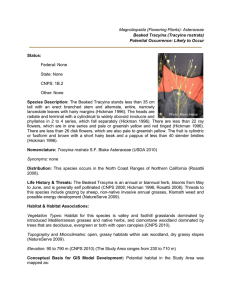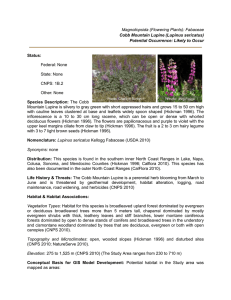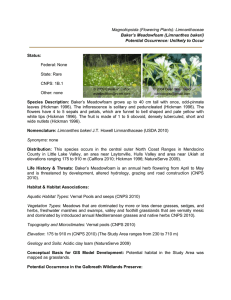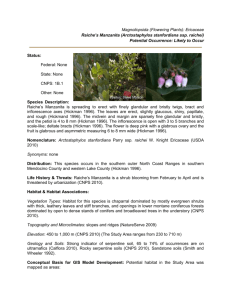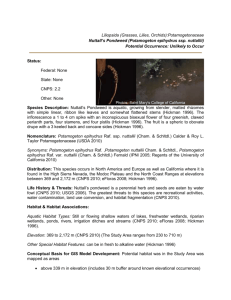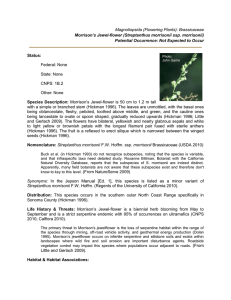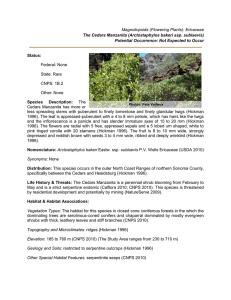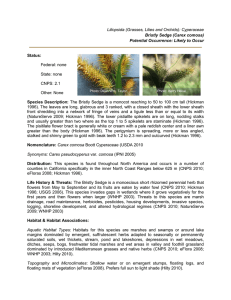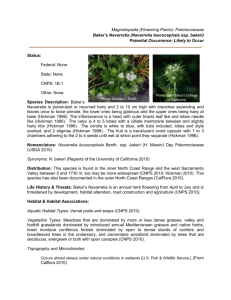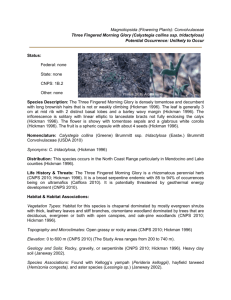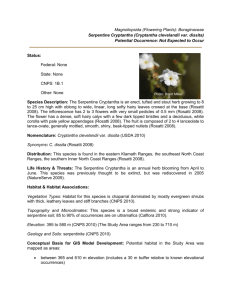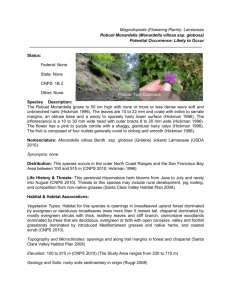CASA Text
advertisement
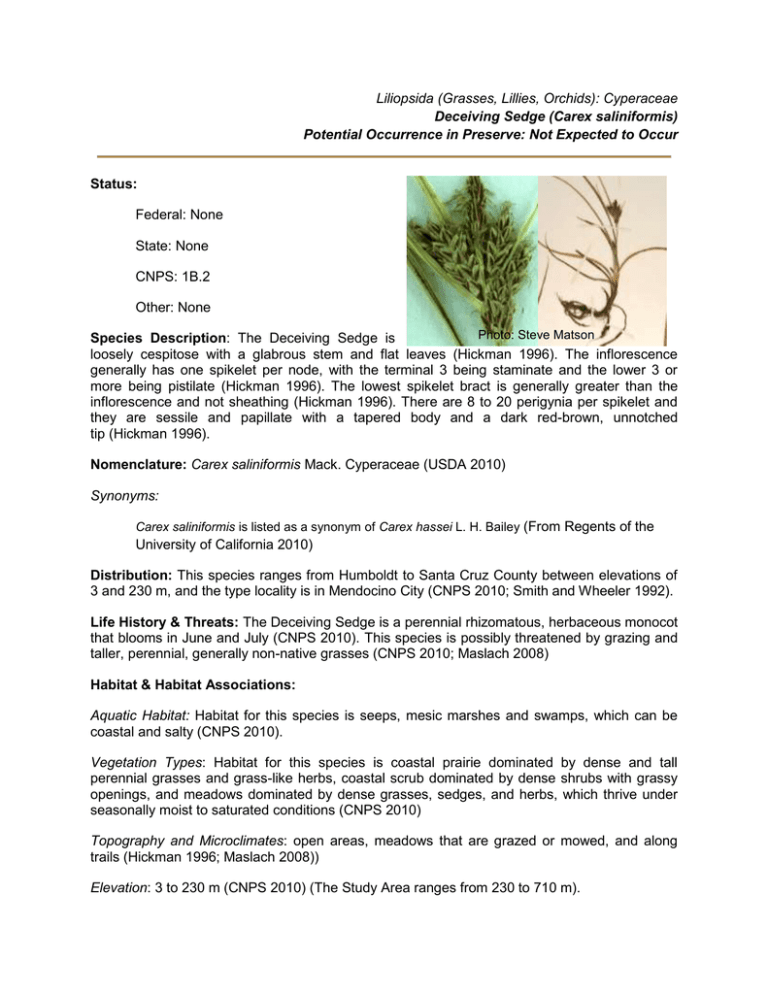
Liliopsida (Grasses, Lillies, Orchids): Cyperaceae Deceiving Sedge (Carex saliniformis) Potential Occurrence in Preserve: Not Expected to Occur Status: Federal: None State: None CNPS: 1B.2 Other: None Photo: Steve Matson Species Description: The Deceiving Sedge is loosely cespitose with a glabrous stem and flat leaves (Hickman 1996). The inflorescence generally has one spikelet per node, with the terminal 3 being staminate and the lower 3 or more being pistilate (Hickman 1996). The lowest spikelet bract is generally greater than the inflorescence and not sheathing (Hickman 1996). There are 8 to 20 perigynia per spikelet and they are sessile and papillate with a tapered body and a dark red-brown, unnotched tip (Hickman 1996). Nomenclature: Carex saliniformis Mack. Cyperaceae (USDA 2010) Synonyms: Carex saliniformis is listed as a synonym of Carex hassei L. H. Bailey (From Regents of the University of California 2010) Distribution: This species ranges from Humboldt to Santa Cruz County between elevations of 3 and 230 m, and the type locality is in Mendocino City (CNPS 2010; Smith and Wheeler 1992). Life History & Threats: The Deceiving Sedge is a perennial rhizomatous, herbaceous monocot that blooms in June and July (CNPS 2010). This species is possibly threatened by grazing and taller, perennial, generally non-native grasses (CNPS 2010; Maslach 2008) Habitat & Habitat Associations: Aquatic Habitat: Habitat for this species is seeps, mesic marshes and swamps, which can be coastal and salty (CNPS 2010). Vegetation Types: Habitat for this species is coastal prairie dominated by dense and tall perennial grasses and grass-like herbs, coastal scrub dominated by dense shrubs with grassy openings, and meadows dominated by dense grasses, sedges, and herbs, which thrive under seasonally moist to saturated conditions (CNPS 2010) Topography and Microclimates: open areas, meadows that are grazed or mowed, and along trails (Hickman 1996; Maslach 2008)) Elevation: 3 to 230 m (CNPS 2010) (The Study Area ranges from 230 to 710 m). Geology and Soils: heavy soil wet during rainy season (Maslach 2008) Species Associations: The Deceiving Sedge has been documented growing with coyote thistle (Eryngium armatum), witchgrass (Panicum capillare), tinker’s penny (Hypericum anagalloides) and coast lotus (Lotus formosissimus). Does not thrive when other taller, perennial, generally non-native grasses are in habitat (Maslach 2008). Conceptual Basis for GIS Model Development: Potential habitat in the Study Area was mapped as areas: below 260 m (a 30 m buffer around known elevational occurrences is included) grasslands. Potential Occurrence in the Galbreath Wildlands Preserve: Habitat: Habitat for Deceiving Sedge is grassland seeps or springs below 230 m. The GIS map indicates that grasslands below 260 m are not present on the Galbreath Wildlands Preserve. In addition, habitat quality is poor. While springs and seeps are common throughout the Galbreath Wildlands Preserve, seeps are typically dominated by rushes (Juncus spp.), sedge (Cyperus eragrostis), mint (Menthe puleglum), bracken ferns (Pteridium aquilium), and this species does not thrive in areas with these tall, perennial species. Nearest Occurrence: Documented Occurrences in the Galbreath Wildlands Preserve: Previous species list for the Galbreath Wildlands Preserve did not document this species (SSU Field Station and Nature Preserves 2010). Nearest Occurrence to the Galbreath Wildlands Preserve: This species is known from from 38 occurrences in Mendocino County, and in counties to the north (Humboldt) and south (Sonoma)(Calflora 2010). All documented occurrences in Mendocino County occur closer to the coast than the Preserve (Calflora 2010). The nearest occurrence is approximately 16 miles southwest of the Preserve in the Gualala River watershed (Calflora 2010). Summary: We anticipate that Deceiving Sedge is “Not Expected to Occur” because grassland seeps do not occur within the known elevational range of this species. References Calflora. 2010. Information on California plants for education, research and conservation. <http://www.calflora.org/> Accessed 2010 Jun 22. California Native Plant Society (CNPS). 2010. Inventory of Rare and Endangered Plants. Online edition, v7-10b. <http://www.cnps.org/inventory> Accessed 2010 Jun 22. Hickman JC editor. 1996. The Jepson Manual Higher Plants of California. 3rded.. London: University of California Press, Ltd. 1134 p. Maslach W. 2008. Botanical Survey and ESHA Assessment. <http://www.gualalamac.com/> Accessed 2010 Jun 24. Matson S. 2003. Carex saliniformis. <http://calphotos.berkeley.edu/cgi-bin/img_query?reltaxon=contains&where-taxon=Carex+saliniformis>. Accessed 2010 Nov 2. Smith GL, Wheeler CR. 1992. A flora of the Vascular Plants of Mendocino County, California. San Francisco: University of San Francisco. 36 p. SSU Field Stations and Nature Preserves. 2010. Galbreath Wildlands Preserve Vascular Plant List. <http://www.sonoma.edu/preserves/docs/galbreath_vascular_plants.pdf>. Accessed 2010 Jun. United States Department of Agriculture (USDA). 2010. PLANTS Profile. <http://plants.usda.gov/java/profile?symbol=CASA6>. Accessed 2010 Nov 2. Species Account Description: Linden Schneider
